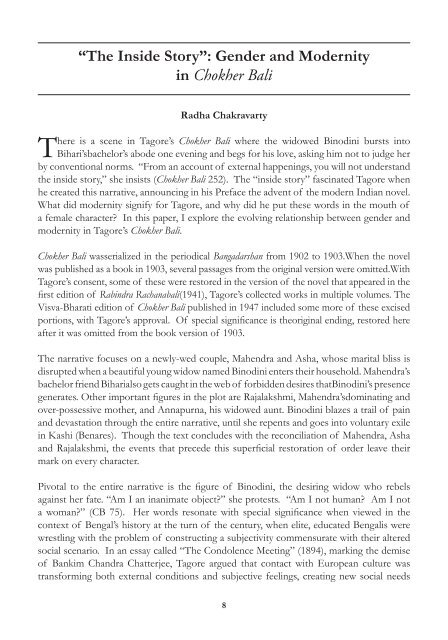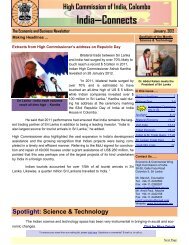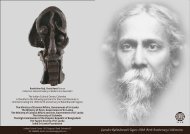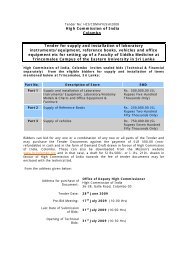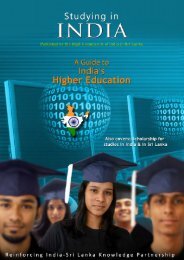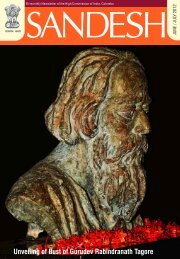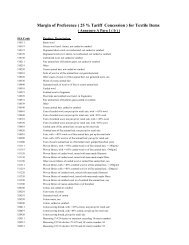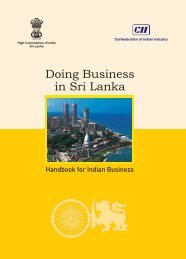Remembering Rabindranath Tagore Volume - High Commission of ...
Remembering Rabindranath Tagore Volume - High Commission of ...
Remembering Rabindranath Tagore Volume - High Commission of ...
Create successful ePaper yourself
Turn your PDF publications into a flip-book with our unique Google optimized e-Paper software.
“The Inside Story”: Gender and Modernity<br />
in Chokher Bali<br />
Radha Chakravarty<br />
There is a scene in <strong>Tagore</strong>’s Chokher Bali where the widowed Binodini bursts into<br />
Bihari’sbachelor’s abode one evening and begs for his love, asking him not to judge her<br />
by conventional norms. “From an account <strong>of</strong> external happenings, you will not understand<br />
the inside story,” she insists (Chokher Bali 252). The “inside story” fascinated <strong>Tagore</strong> when<br />
he created this narrative, announcing in his Preface the advent <strong>of</strong> the modern Indian novel.<br />
What did modernity signify for <strong>Tagore</strong>, and why did he put these words in the mouth <strong>of</strong><br />
a female character? In this paper, I explore the evolving relationship between gender and<br />
modernity in <strong>Tagore</strong>’s Chokher Bali.<br />
Chokher Bali wasserialized in the periodical Bangadarshan from 1902 to 1903.When the novel<br />
was published as a book in 1903, several passages from the original version were omitted.With<br />
<strong>Tagore</strong>’s consent, some <strong>of</strong> these were restored in the version <strong>of</strong> the novel that appeared in the<br />
first edition <strong>of</strong> Rabindra Rachanabali(1941), <strong>Tagore</strong>’s collected works in multiple volumes. The<br />
Visva-Bharati edition <strong>of</strong> Chokher Bali published in 1947 included some more <strong>of</strong> these excised<br />
portions, with <strong>Tagore</strong>’s approval. Of special significance is theoriginal ending, restored here<br />
after it was omitted from the book version <strong>of</strong> 1903.<br />
The narrative focuses on a newly-wed couple, Mahendra and Asha, whose marital bliss is<br />
disrupted when a beautiful young widow named Binodini enters their household. Mahendra’s<br />
bachelor friend Biharialso gets caught in the web <strong>of</strong> forbidden desires thatBinodini’s presence<br />
generates. Other important figures in the plot are Rajalakshmi, Mahendra’sdominating and<br />
over-possessive mother, and Annapurna, his widowed aunt. Binodini blazes a trail <strong>of</strong> pain<br />
and devastation through the entire narrative, until she repents and goes into voluntary exile<br />
in Kashi (Benares). Though the text concludes with the reconciliation <strong>of</strong> Mahendra, Asha<br />
and Rajalakshmi, the events that precede this superficial restoration <strong>of</strong> order leave their<br />
mark on every character.<br />
Pivotal to the entire narrative is the figure <strong>of</strong> Binodini, the desiring widow who rebels<br />
against her fate. “Am I an inanimate object?” she protests. “Am I not human? Am I not<br />
a woman?” (CB 75). Her words resonate with special significance when viewed in the<br />
context <strong>of</strong> Bengal’s history at the turn <strong>of</strong> the century, when elite, educated Bengalis were<br />
wrestling with the problem <strong>of</strong> constructing a subjectivity commensurate with their altered<br />
social scenario. In an essay called “The Condolence Meeting” (1894), marking the demise<br />
<strong>of</strong> Bankim Chandra Chatterjee, <strong>Tagore</strong> argued that contact with European culture was<br />
transforming both external conditions and subjective feelings, creating new social needs<br />
8


